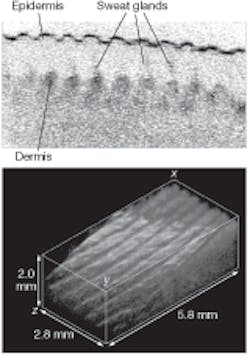OPTICAL-COHERENCE TOMOGRAPHY: CMOS camera makes 2-D OCT images possible without scanning

Using an ultra-high-speed CMOS camera, researchers at Yamagata University (Yamagata, Japan) can acquire 2-D images of human tissue with a technique they call axial-lateral parallel time-domain optical-coherence tomography (OCT).1 A sample volume of 5.8 x 2.8 x 2.0 mm3 (corresponding to 512 x 250 x 512 pixels) can be obtained in 1/6 s based on an OCT frame rate of 1500 frames per second (fps) with additional lateral scanning.
Current OCT techniques are capable of imaging biological tissues with approximately 10 µm resolution at depths of a few millimeters. While time-domain OCT (TD-OCT) yields cross-sectional images through axial and lateral scanning, Fourier-domain OCT (FD-OCT) offers higher sensitivity and faster imaging speed. A variation of FD-OCT, spectral-domain OCT (SD-OCT) detects the spectrally resolved interference signal with a spectrometer that consists of a high-efficiency diffraction grating and a high-speed line camera at each lateral position. Although parallel 2-D OCT techniques have been developed that use silicon detector arrays and CCD arrays as imaging sensors to obtain transverse cross-sectional images, the area obtained in the images has been limited to less than 100 x 100 pixels and frame rates for data acquisition are slow (less than 200 fps).
Very high frame rates
Now 2-D in vivo images of the human finger at camera rates greater than 1000 fps have been achieved using the axial-lateral parallel TD-OCT technique. In the experimental setup, a beamsplitter divides the collimated output from an 831 nm superluminescent laser diode into signal and reference beams. A cylindrical lens with a 50 mm focal length is inserted in the signal arm to illuminate the sample with a linear beam that can be moved horizontally by a galvanometer scanner. A reflective grating is installed in the Littrow configuration so that first-order diffracted light propagates backward along the incoming path at the reference beam to obtain a continuous delay. The backscattered light from the sample and the diffracted light from the grating are imaged onto a Photron (San Jose, CA) CMOS camera (512 x 512 pixels, 17 x 17 µm pixels, 10-bit resolution, maximum rate 6000 fps) using an achromatic imaging lens with 100 mm focal length. The diffraction grating is placed on a piezoelectric transducer to shift the phase difference between the signal and reference beams. The observed axial-lateral interference image contains interference and noninterference signals.
Once the OCT image is calculated for a 512 x 512-pixel region, further calculations from two sequential interference images are used to eliminate noninterference components for imaging biological tissues in vivo. Because achromatic cylindrical lenses are not commercially available, there are aberrations due to the plano-convex singlet cylindrical lens used. Measurement of a test target yielded an approximate vertical resolution of 28 µm (36 line pairs/mm) and a lesser horizontal resolution of 35 µm (28.5 line pairs/mm) due to these cylindrical-lens aberrations.
Measured sensitivity of the OCT system at different frame rates yielded values of 80, 76, and 72 dB at 1000, 3000, and 6000 fps, respectively. The 72 dB sensitivity corresponds to that of a high-speed full-field OCT (FF-OCT) system at 500 fps; however, it is less sensitive than FD-OCT techniques, and therefore depth measurement is limited to a few hundred microns.
The image of a human finger in vivo was first obtained without a horizontal scan to obtain a 2-D image (see figure). To create a 3-D image, the linear probe beam was scanned at 3 Hz to obtain volume data. Five hundred interference images per scan (corresponding to 250 OCT images through calculations from two sequential images) created a 3-D dataset of 512 x 250 x 512 pixels.
“Although the parallel SD-OCT technique also provides a 3-D image with additional lateral scanning, OCT images contain a mirror image and suffer from a reduction in the signal-to-noise ratio (SNR) with increasing depth range,” says researcher Yuuki Watanabe. “The advantages of the axial-lateral parallel TD-OCT technique are that it is artifact-free and has the same signal-to-noise ratio for increasing depth range compared to standard FD-OCT. Since this technique has advantages of simple optical configuration and simple calculation, a compact OCT system can be developed for future work.”
REFERENCE
1. Y. Watanabe et al., Optics Express 14(12) 5201 (June 12, 2006).
About the Author

Gail Overton
Senior Editor (2004-2020)
Gail has more than 30 years of engineering, marketing, product management, and editorial experience in the photonics and optical communications industry. Before joining the staff at Laser Focus World in 2004, she held many product management and product marketing roles in the fiber-optics industry, most notably at Hughes (El Segundo, CA), GTE Labs (Waltham, MA), Corning (Corning, NY), Photon Kinetics (Beaverton, OR), and Newport Corporation (Irvine, CA). During her marketing career, Gail published articles in WDM Solutions and Sensors magazine and traveled internationally to conduct product and sales training. Gail received her BS degree in physics, with an emphasis in optics, from San Diego State University in San Diego, CA in May 1986.